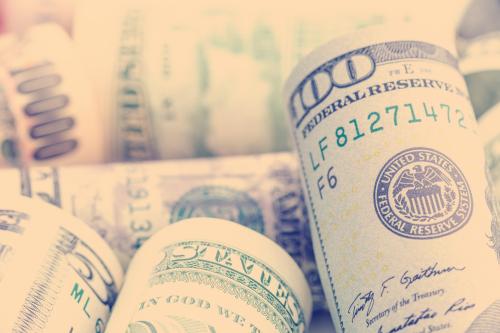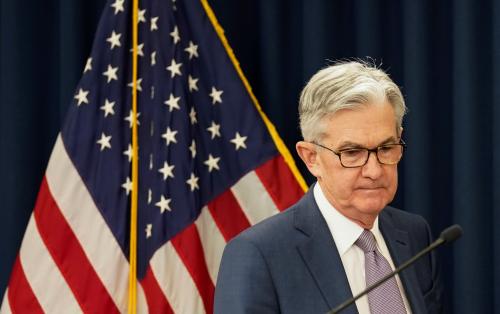This piece was updated on August 3, 2020, and again on January 25, 2021.
The U.S. government and its counterparts all over the world are spending trillions of dollars in response to the COVID-19 crisis, borrowing trillions of dollars to do so. Here are some answers to questions we’ve been hearing and discussing.
Where is all the money the U.S. is spending coming from?
Savings: The world has been and still appears to be awash in savings, one big reason interest rates on U.S. Treasury debt–and debt of many foreign governments–were so low before COVID-19 hit. This suggests that there is ample room to increase borrowing now at a relatively low cost.
Portfolio shifts into U.S. Treasury debt: People and institutions with savings are particularly eager to invest the money in U.S. Treasury debt right now. At times of crisis, institutions, individuals, and foreign governments often prefer the safety of Treasuries instead of putting their money into the stock market, corporate bonds, or real estate. For instance, billions of dollars have moved from money market mutual funds that invest in corporate short-term IOUs to money market funds that invest solely in U.S. government debt. This makes it easier for the U.S. Treasury to borrow more without being forced to pay much higher interest rates.
Central banks: The Federal Reserve can and does create money, and it can and does use that money to buy government bonds. That’s what the Fed did during the Great Recession of 2007-09, and that’s what it is doing now. To be precise, the Fed isn’t giving money directly to the Treasury. The Fed is, in effect, buying government IOUs (Treasury bonds) from private investors or foreign governments who have lent money to the Treasury. But, of course, the more the Fed buys, the lower the interest rates that the government has to pay on new borrowing, and the more the U.S. Treasury can borrow overall without pushing up that interest rate. (For details on what the Fed is doing, click here.)
Does this mean the U.S. government can spend an unlimited amount of money?
No. There is only so much the government can borrow without raising interest rates and crowding out private investment. That would hurt economic growth. But with interest rates at historic lows (inflation-adjusted, or real, interest rates are actually negative), there is a lot of room to increase borrowing without having to worry too much right now about impairing private investment. This is especially true now when investment demand is likely to be very low in the face of the uncertain economic outlook associated with the pandemic. Even if interest rates rise in response to the huge increase in borrowing by governments around the world (though this is by no means certain), rates are likely to remain quite low by historic standards.
There may, however, be political constraints on how much the government can increase its debt and how much government debt the Fed can buy. The Fed drew criticism for its bond-buying during the Great Recession, though it hasn’t during the coronavirus crisis (yet).
At some point, if central banks create too much money, they will produce an increase in inflation–too many dollars chasing too few goods–or they will have to raise interest rates to slow the economy to restrain inflation. We are not yet at that point, though.
OK, this sounds a little too good to be true: The Fed can simply keep printing money, buying government bonds, and the government can spend as much as it wants and protect the economy from damage done by the virus?
No. For all its power, the Federal Reserve cannot do much to compensate for damage done to the economy’s production and consumption of goods and services during the epidemic–the restaurant meals that aren’t being provided, the trips that aren’t being taken, the cars that aren’t being built. Some hit to output (GDP) is inevitable if we are to safeguard public health.
Beyond taking action to minimize the severity of the epidemic by boosting testing and hospital capacity, the government can provide financial help to people during the crisis so that they can pay basic expenses like food, rent, and utilities. This helps not only ensure that people don’t go hungry or become homeless, it also means that they come out of this crisis with money in their bank accounts and their credit ratings unimpaired. In other words, once it is safe to start shopping and traveling again, consumers will have the means to do so. If they don’t, temporary problems associated with lower demand during the crisis will translate into lower demand well even after the virus ebbs.
Another role for government is to keep businesses on life support for a few months so they don’t go bankrupt and we can more easily re-start the economy when the virus recedes; in other words, to limit the long-run damage to the economy’s productive capacity. A few bankruptcies would be manageable; mass bankruptcies would not be. Sure, new businesses will sprout, but it takes time to hire workers and find suppliers and creditors to get a new business running.
The federal debt was large by historical standards before the coronavirus crisis. Is it a problem that it’s going to get a lot bigger?
Even before the COVID-19 crisis, the federal debt, measured against the size of the economy, was more than twice what it was before the Great Recession (80 percent of GDP vs. 35 percent at the end of 2007) and larger than at any time in U.S. history except immediately after World War II. The pandemic and the federal response to it will add substantially to the debt. The federal debt at the end of fiscal year 2020 (September 30, 2020) had already reached 98 percent of GDP, and that doesn’t include the $900 billion fiscal package enacted in December 2020 or any additional COVID relief that may be enacted this year. At times like these—like times of war—government borrowing to fund essential spending is prudent if the alternative is devastation, economic or otherwise. As long as interest rates remain low, the government can shoulder a heavier burden of debt than if rates were higher. Yes, we are passing the bill onto future generations, but with interest rates this low, that bill is probably pretty small. In any case, the alternative—not doing the fiscal stimulus necessary to keep the economy afloat and get it restarted after the virus recedes—would likely be worse for future generations.


The charts show CBO projections of federal debt and net interest payments as a share of GDP over the next 30 years. The red lines show the January 2020 (pre-COVID) projection, and the blue lines show the September 2020 (post-COVID) projection. The huge increase in borrowing since COVID began boosts the level of the federal debt, but doesn’t have much effect on its growth over time. The decline in interest rates since the beginning of the pandemic means that net interest payments as a share of GDP are actually projected to be lower over the next 12 years than they were projected to be before the pandemic despite the much higher debt. And even though the debt to GDP ratio has more than doubled since the late 1980s and early 1990s, interest payments over the next decade are projected to be a smaller share of GDP than they were back then.
Looking forward, it remains true that the federal debt is on an unsustainable path, largely because of the aging of the population (the more older folks, the more spending on Social Security and Medicare), and because health care spending (much of that paid by government) is growing faster than the economy. We’ll have to deal with the rising federal debt eventually, but not now.
The Brookings Institution is committed to quality, independence, and impact.
We are supported by a diverse array of funders. In line with our values and policies, each Brookings publication represents the sole views of its author(s).









Commentary
Where is the US government getting all the money it’s spending in the coronavirus crisis?
March 25, 2020